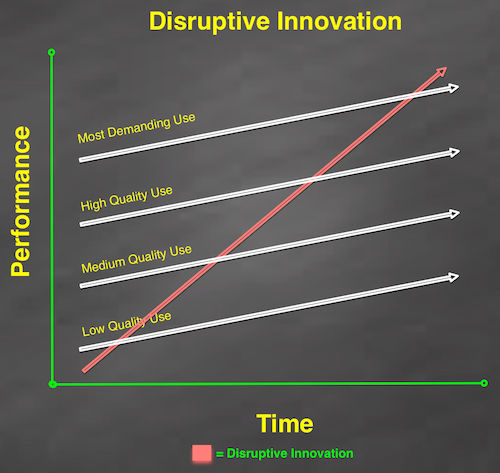A few weeks ago one of my engineers sent around a link to the project JAWS, an open source framework for building server-less applications using JavaScript and Lambda. While at first glance it might seem as though it’s just another interesting cloud project, for me it signified something else: another sign that the shift to the next-generation of cloud computing is underway.
Early Use of Disruptive Innovations
When disruptive innovations are first introduced, there is a natural tendency to use them like the predecessor technology. Only after the disruptive technology matures and its use reaches an early majority, does its full potential become apparent.
We can illustrate this tendency with three examples:
Example #1: Digital Cameras
When we first used a digital camera, they came in a similar form factor and had similar features / functions that mirrored traditional film-based cameras. In those early days, our goal with a digital camera was to get our pictures to paper media, through online and personal photo printers. But as the technology moved beyond its initial underserved market, the quality of the cameras increased and companies pioneered new ways to take advantage of digital photography. The result: today we are more likely to take pictures with our phone or tablet, directly uploading to social media channels, manipulating as desired, and forever forgoing the need for share paper pictures.
Example #2: Smartphone
The earliest versions of the smartphone attempted to recreate one or more functions of your desktop or laptop (e.g. email, web browsing). They did so with a reduced feature set and user experience. The pinnacle of the early smartphones - the Blackberry - achieved its success by providing an almost comparable email experience to a traditional desktop. This of course all changed with the introduction of the iPhone, where suddenly we began to see the smartphone as a new class of device with the potential to do things previously not possible with our laptops / desktops (e.g. mobile payments, mobile games, GPS, digital camera, TV, electronic tickets, hailing taxis). The result: today the smartphone is an indispensable device that has a purpose independent of extending your desktop.
Example #3: Social Media
I built an early social media site back in the mid-1990s (FireFly Venues) that was a contemporary to several of the first generation platforms (e.g. Geocities, Tripod). Our goal back then was to try to mimic traditional forms of communication in the real world. Chat was a way to reproduce verbal communication, profile pages were a way to look people up, and discussion boards were a way to have an asynchronous water cooler conversation. Most of these early sites promoted virtual identities that allowed early users to anonymously build a new persona online. It wasn’t until sites like Classmates.com, SixDegrees.com and Friendster that social media started being used as an extension of your actual identity. With a real identity and real connections came the realization of the full disruptive potential of social media, which has reshaped how we acquire news, meet people, maintain friendships, support causes, find jobs, and so much more.
Next Phase of Cloud Computing
For all its disruptive potential, cloud computing has been primarily used as a better form of virtualization. This is evidenced by the heavy adoption / standardization around Infrastructure as a Service (IaaS), which provides on-demand compute and storage that directly mirrors its predecessor technologies. For most of the first decade, we’ve taken workloads that could have run on predecessor technologies and moved them to the cloud, occasionally sprinkling in a few features that hint at the full disruptive potential of this technology (e.g. auto-scaling, highly durable key value storage, auction-based compute, infrastructure as code).
But like any disruptive innovation, we are now on the verge of rising above our inclination to use the technology in a familiar way. Our future is not to be chained to virtual machines or containers, but to run complex and highly available applications without infrastructure or boundaries to our workloads. Our future is to create new classes of applications that wire together heterogeneous services from multiple cloud providers into seamless and rich applications. These applications will enable us to solve for higher forms of complexity in our software, and substantially reduce the cost of maintaining / supporting traditional applications.
Paraphrasing Winston Churchill, we are not at the end, nor are we at the beginning of the end, but rather at the end of the beginning of cloud computing. Welcome to the next phase of cloud computing, where we begin the realize the full potential of the disruption.
Related posts: Disruption in the Cloud, Predicting Disruptive Innovation, Day 3 at re:Invent: Disruption Achieved
